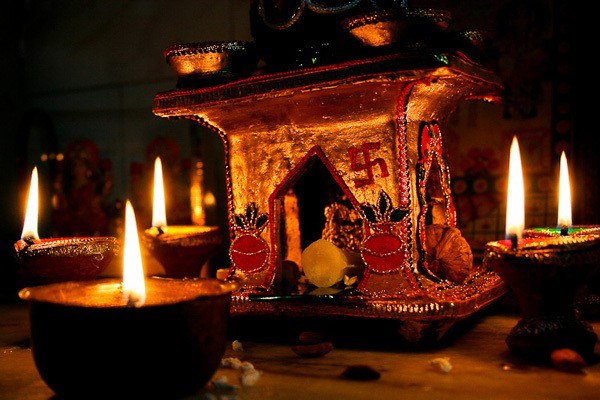While being on the eve of Deepavali I thought of writing about its origin. Deepavali can be broken to deepa and awali, meaning a chain of lamps.

Googling & going through the Sanskrit version of Rāmāyana by Vālmiki, I could find these references, as Hanumān informed the arrival of Lord Rāma to King Bharata, upon which the latter announced:
समीकुरुत निम्नानि विषमाणि समानि च || ६-१२७-६
स्थानानि च निरस्यन्तां नन्दिग्रामादितः परम् |
Let the cavities on the path from Nandigrama to Ayodhya be levelled. Let the rough and the even places be made flat.
सिञ्चन्तु पृथिवीं कृत्स्नां हिमशीतेन वारिणा || ६-१२७-७
ततॊ ऽभयवकिरंस तव अन्ये लाजैः पुष्पैश च सर्वतः |
Let the entire ground be sprinkled with ice-gold water. Let some others strew it all over with parched grains and flowers.
समुच्छ्रितपताकास्तु रथ्याः पुरवरोत्तमे || ६-१२७-८
शोभयन्तु च वेश्मानि सूर्यस्योदयनं प्रति |
Let the streets in Ayodhya, the excellent City, be lined with flags. Let the dwellings (on the road-side) be decorated, till the time of rising of the sun.
The whole land between Nandigrām and Ayodhyā was decorated with flags and roadside houses were decorated till the rising sun; which meant they were adorned for the whole night. That indeed tells us the decorations meant to be luminous.
Nandigrām was the place where Lord Rāma’s vimāna (flying chariot) landed.
####Other references on Deepavali
The kind of luminous Deepavali we refer is also mentioned in the KāmaSutrā texts by sage Vātsyāyana. As recommended by the sage, the most celebrated night is that of the Yaksha. On the Yaskha-night houses are illuminated with tiny earthen lamps placed in rows close to each wall and window ledges, and the gardens should have bonfires (sounds familiar to our current tradition). Yakshas are believed to be celestial beings who are mostly inclined to enjoyment. Sage Vātsyāyana thus recommends celebrating the night with light, merriment and gambling. This still continues on Divali nights … something I never was able to associate with Rāmāyana. Some said gambling formed part as we also welcome Mother Lakshmi and Shree Kubera on the day/night of Deepavali. Yet I couldn’t digest something tāmasic as gambling & merriment being associated with the festival.
I think I’d rather accept the recommendation of Sage Vātsyāyana as being the plausible explanation of gambling & enjoyment during Divali celebration. The amāvasyā of Kārthika is believed to be the darkest night of the year just as Sage Vātsyāyana explains the night of Yaksha being the darkest.
More reading
Deepawali: The Indian Festival of Light
Vālmiki Rāmāyan in Sanskrit
The Kama Sutra of Vatsyayana by Sir Richard Burton
Image source : http://bloggr.in/2013/10/15-reasons-stop-bursting-crackers-diwali